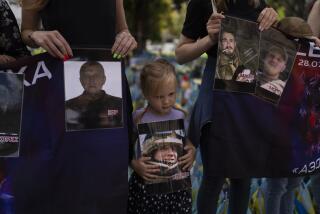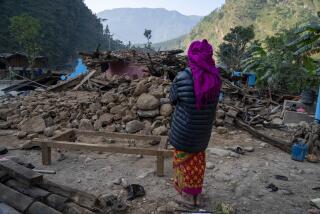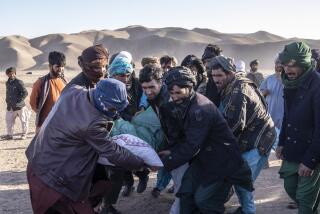Soviet Press Criticizes Relief Effort : Poor Organization Charged; ‘Lives at Stake,’ Pravda Says
MOSCOW — As rescue workers struggled to save those victims of the Armenian earthquake still alive beneath the rubble of collapsed buildings, official criticism began to emerge Monday that the relief effort needed better organization.
Valuable time was lost immediately after the magnitude 6.9 earthquake Wednesday morning through a lack of preparedness, articles in the official Soviet press asserted. In addition, more time was lost later through poor coordination, and time is now critical if lives are to be saved, the commentaries asserted.
“Hours were lost, and time means lives,” the Communist Party newspaper Pravda commented, urging intensified efforts to find and rescue the thousands of people believed to be still trapped. “It is bitter to talk about all this, but it is necessary--lives are at stake.”
Another Plane Crash
The crash of the second relief plane in two days--this one a Yugoslav transport with seven crew members aboard--dramatized the hidden dangers in the massive relief effort itself.
Hundreds of aircraft--most of them part of an “air bridge” bringing supplies from other parts of the Soviet Union and evacuating residents, but some carrying medicine and rescue workers from abroad--are now in the skies over Armenia in the southern Soviet Union. The congestion requires some of the best air traffic control work in the world.
The Yugoslav plane crashed about 8 miles from Zvartnots Airport in Yerevan, the Armenian capital, while preparing to land about 2:30 a.m. Monday. The cause of the crash was not immediately clear, Soviet aviation officials said, and an international commission will investigate it.
On Sunday, a Soviet military transport crashed before dawn near Leninakan, one of the worst-hit cities in the earthquake, and 78 crew members and soldiers aboard were killed. Aviation officials Monday denied an earlier report by Armenian government spokesmen that the plane had collided with a helicopter, but they could provide no reason for the crash.
Lamenting these additional deaths, the government newspaper Izvestia commented Monday evening: “In the airspace, there is the same kind of commotion as on the ground. Sometimes there are several dozen planes circling, waiting to land.”
But Boris Panykov, first deputy minister of civil aviation, told a news briefing here that, despite the two crashes, air safety standards had been maintained. “If we could not ensure security, we would refuse entry into our airspace,” Panykov declared, nevertheless acknowledging “a dramatic increase” in air traffic.
Such sharp questioning and often-critical comments are beginning to emerge as the country absorbs the initial shock of the Armenian tragedy. Officially, 40,000 to 45,000 people are said to have died in the earthquake and its aftermath, but the unofficial estimates run as high as 100,000. The Soviet leadership is now demanding better coordination to “save those who can still be saved.”
The primary goal remains the painstaking search of the collapsed buildings, many of them schools, factories and department stores, for people buried alive in the rubble.
Going by the experience of other major earthquakes, including the one in Mexico in September, 1985, Soviet officials believe that some people will survive as long as 10 days and even two weeks, and so almost a week after the quake they are urging intensified rescue efforts.
“Lives are at stake--it is not too late to save people!” Premier Nikolai I. Ryzhkov told a press conference in Yerevan on Monday. “Every life is precious to us. We must continue.”
The government’s sensitivity to criticism was underscored by Ryzhkov’s unexpected announcement that the Armenian nuclear power plant, which the government said last week had withstood the earthquake without damage, will be closed and deactivated over the next two years “to meet the wishes of the Armenian public.”
Although the government has full confidence in the plant, which stands on the edge of Wednesday’s quake site, and in its safe operation, Ryzhkov said officials had decided to respond to calls by Armenian environmentalists--and nationalists--for its closure.
Boris Y. Shcherbina, a deputy premier who oversaw the government reaction to the Chernobyl nuclear disaster, has now been placed in direct operational control of the rescue and relief effort, according to government officials.
64 More Are Saved
Sixty-four people were rescued Monday from the rubble at Leninakan, the main focus of the relief effort, according to the official Soviet news agency Tass, bringing the total number rescued there to 5,389.
Overall, approximately 18,500 were rescued in the first four days after the earthquake, Tass reported, but more than 90% of those were found in the first 36 hours.
A rescue headquarters established in Leninakan, Armenia’s second-largest city before 80% of it was destroyed last week, is now coordinating the work of rescue teams focusing on buildings where large numbers of people had lived, according to a report by a correspondent of the official Tass news agency.
Until the weekend, the teams apparently dug wherever someone had heard, or thought he had heard, a human voice from beneath the rubble. Many major buildings were bypassed in that hurried effort, Tass said, and the teams were now going back to work more methodically.
Cranes, bulldozers and other heavy equipment, badly needed for the careful removal of the debris, have now arrived in large numbers in Leninakan and most of the other hard-hit cities and towns, but it has taken almost four days to gather them and transport them here.
“All the lessons of previous disasters should have taught us something,” Pravda commented, criticizing what it termed poor crisis management at the initial stages of the rescue and relief effort.
“People were not aware of what was needed, and in what quantities, so only a few (heavy-duty cranes) were brought. . . . Even the smallest mistake is measured in human lives.”
The point of the articles in Pravda, Izvestia and other major Soviet newspapers was not to portray the relief effort as a shambles, but to underscore the need for greater coordination now as well as in the future.
At Yerevan’s Zvartnots airport, dozens of airplanes, many of them international flights, sat on the tarmac Monday waiting to be unloaded; groups of student volunteers have now been assigned to clear the backlog of cargo.
At Leninakan, the airport’s main runway was closed for five hours while food was unloaded from a single plane--effectively closing down the airlift of supplies from around the country.
Admiring the efficiency of the 168-member French search-and-rescue team backed by highly skilled surgeons, Pravda noted how they quickly went to work after their arrival, setting up their base, complete with a portable generator, and then using high-technology devices and sniffer dogs trained to detect people buried in the rubble.
“Specialists, equipment, dogs--we have all of those,” the paper said. “But each belongs to a different agency, and instead of working with a clenched fist, we have an open palm. The question is now to unite because we need a quick reaction unit for disasters.”
In another telling comment, Pravda noted that the French team was made up totally of specialists, but the Soviet teams, some of which have saved many people, typically have “10 observers proffering advice for each worker.”
International assistance continues to pour into Armenia. Valentin M. Nikiforov, a deputy foreign minister, told a press conference here Monday that already 38 flights from 23 counties have brought relief supplies. He said that there were 923 foreign rescue workers in Armenia along with 216 sniffer dogs. The Soviet Union, he said, has received direct assistance from 46 countries.
Some of the sharpest criticism of the Soviet domestic effort came from Ryzhkov, chairman of the special commission established by the Communist Party’s ruling Politburo, to oversee the government efforts.
Returning from a tour of rural areas, where damage was also heavy, Ryzhkov spoke bitterly of the bureaucracy hampering relief efforts in the Armenian countryside.
At one village, government workers bringing food refused to unload it and drove it back to the warehouse when none of the local officials authorized to receive it could be found--they had all died in the earthquake.
In other areas, police have demanded that residents complete lengthy death reports and funeral paper work before burying their relatives, according to Izvestia, which described them as apparently unaware that, following such a disaster, quick burial is necessary to prevent epidemics.
And from Spitak, previously described as “erased from the face of the Earth,” a Radio Moscow correspondent reported: “It is extremely hard to carry out the rescue work. There are no communications, no electricity, no heavy cranes. The streets are blocked with vehicles and people.”
Half the town’s population of 20,000 is still buried--whether they are alive or dead is not known, the correspondent said--and many of the 35,000 residents living in nearby villages and hamlets were also reported trapped in the rubble of their homes and farm buildings. Only a few hundred residents of Spitak are known to have survived the earthquake.
Ryzhkov said that 28 villages were destroyed and 120 others badly damaged.
More to Read
Sign up for Essential California
The most important California stories and recommendations in your inbox every morning.
You may occasionally receive promotional content from the Los Angeles Times.










